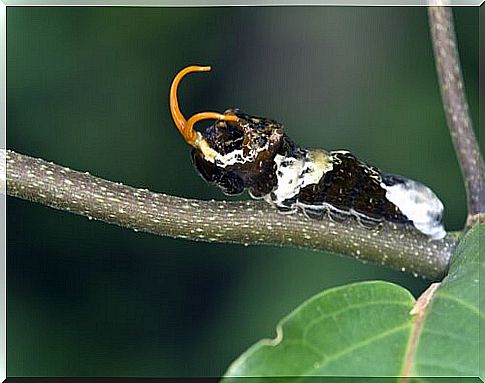The Giant Swallowtail Butterfly: An Exotic Species

The giant swallowtail butterfly or Papilio cresphontes is a surprising insect with an exotic appearance and widespread in the American continent. He is a welcome visitor to gardens, plantations and landscapes in general.
In the larva stage it is considered a plague due to its habit of feeding on the foliage of most of the Citrus species . Some larvae can quickly defoliate small or young plants; however, they may not be a problem in large citrus trees. Let’s get to know the giant swallowtail butterfly together .
Geographical distribution of the giant swallowtail butterfly
This specimen is widely distributed throughout the American continent. It stretches from southern New England through the states north of the Great Lakes to Ontario, through areas south of the Great Plains to the Rocky Mountains.
It is also found in the Caribbean, southeastern United States, Mexico, Central and South America. It is also common throughout Florida.
Morphological characteristics
The adult giant swallowtail butterfly can measure around 14cm and the female around 14.7cm. The surfaces of the dorsal wing are black with a diagonal yellow stripe running across the front wings.
The surfaces of the ventral wing are mainly yellow. The queue may vary in tone depending on the geographic location. Some tails are completely yellow, others all black, and still others are bright red within the blue stripe in the rear ventral wing.

The 5 larval stages differ in appearance, however all of them bear a resemblance to bird droppings due to their small size, especially in the juvenile stages.
The mature larvae generally rest on the stems or petioles of the leaves, but the younger ones settle on the upper surfaces of the leaves. The latter are black or brown with a white stripe and have prominent hairs.
Life cycle of giant swallowtail butterfly
The adult giant swallowtail butterfly drinks the nectar of many flowers and is common to see in gardens where azaleas, Bougainvillea, Japanese honeysuckle, Canadian Goldenrod, and Asclepias incarnata abound. He can also drink the liquid from the dung.
Adult males scour pine woods or citrus groves for females. They fly quickly by taking many breaks and can travel long distances. Courtship and mating occur in the evening.
Females typically lay their eggs individually on the upper surface of host plant leaves. The eggs are spherical, cream or brown in color, and measure from 1 to 1.5 mm. They are irregularly covered with an orange secretion that resembles the appearance of orange peel.

The larvae can undergo metamorphosis into small branches of host plants or can travel a short distance to a vertically oriented structure, such as a fence or other plant. The brownish chrysalis is oriented at 45 ° with respect to the substrate of the pupa. At least two or three generations are born each year in Florida.
Biological control
The larvae of the giant swallowtail butterfly are considered a minor orange plague. Larvae host plants include members of the citrus family, white sapote, and other exotic plants.
The pupae stand still and are defenseless against parasitic insects. In the larval stages they are safer from enemies than in the pupae stages. The larvae defend themselves from predators, whether they are insects or invertebrates, as well as from parasites to be less visible through the coloring and cryptic traits. That is, to resemble bird droppings.
In addition, the larvae have a gland in the middle part behind the head, which they use when attacked by small predators. This gland secretes very noxious and pungent chemicals that release a rancid odor. They are repellent and toxic to predators, such as ants and spiders.









